What Are The Differences Between The Focus On Technique In Traditional Martial Arts And The Competitive Focus Of Contemporary Combat Sports? Check Out The Necessary Differences That Can Affect Your Course
What Are The Differences Between The Focus On Technique In Traditional Martial Arts And The Competitive Focus Of Contemporary Combat Sports? Check Out The Necessary Differences That Can Affect Your Course
Blog Article
Material By-Thuesen Hovgaard
When you consider martial arts, do you lean more towards the conventional methods or the modern-day battle sports? Each path supplies distinct advantages and experiences, shaped by their viewpoints and training approaches. Conventional martial arts emphasize individual development and discipline, while modern-day combat sporting activities concentrate on competitors and performance. Comprehending these differences can assist you in choosing the appropriate approach for your journey. Yet how do these distinctions materialize in training and approach?
The Ideology and Background Behind Conventional Martial arts
While lots of people associate martial arts with physical combat, the philosophy and history behind conventional martial arts run much deeper. You'll locate that these self-controls emphasize personal growth, self-control, and respect.
Originating from martial arts gym , traditional martial arts were frequently created for Self-Defense and spiritual growth. They symbolize concepts such as balance, harmony, and self-control, guiding specialists beyond mere battling skills.
As you educate, you'll not just learn strategies however likewise acquire understandings into the culture and values that shaped these arts. The routines and practices, frequently given via generations, promote a feeling of neighborhood and belonging.
The Affordable Nature of Modern Fight Sports
Modern battle sports have actually transformed the landscape of martial arts into a very competitive sector, where professional athletes face off in a test of skill, strategy, and endurance.
You'll discover that competitions are usually arranged with strict policies and guidelines, ensuring justice and safety and security. These occasions draw in large audiences, fueling the enjoyment and intensity of matchups.
Athletes educate rigorously, not just for physical expertise however also for psychological toughness, understanding that every information counts in the ring. The adrenaline thrill throughout competitions is palpable, as fighters push their limitations to assert triumph.
https://www.marinij.com/2021/12/21/marin-kids-best-kept-pandemic-survival-secret-karate/ and virtuosity included, making contemporary fight sporting activities a thrilling phenomenon that continues to advance and mesmerize enthusiasts worldwide.
Training Methods and Methods: A Relative Analysis
The affordable ambience of modern-day battle sporting activities needs innovative training techniques that vary significantly from typical martial arts.
In contemporary training, you'll focus on specific techniques, competing, and conditioning, usually making use of drills that imitate actual fight scenarios. You'll see an emphasis on quantifiable performance and regular competition to evaluate your skills.
In contrast, standard martial arts prioritize types, katas, and thoughtful trainings, typically highlighting technique and regard over competition.
Training is typically less intense and may entail repetitive method as opposed to real-time sparring.
While both strategies construct skill and health and fitness, contemporary battle sports give a much more dynamic and adaptable training environment, preparing you for prompt obstacles in the ring or cage.
Choose the path that aligns with your goals and interests.
Verdict
In picking in between conventional martial arts and contemporary combat sporting activities, it truly boils down to what you value a lot of. If you're trying to find personal growth, technique, and a feeling of community, standard arts may be your finest fit. Yet if you grow on competition and real-time obstacles, modern combat sports could be the means to go. Ultimately, both paths offer special advantages, so it's everything about straightening your training with your personal objectives and rate of interests.
